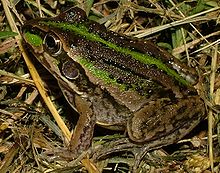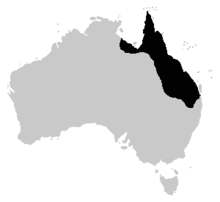- Striped Burrowing Frog
-
Striped burrowing frog 
Conservation status Scientific classification Kingdom: Animalia Phylum: Chordata Class: Amphibia Order: Anura Family: Hylidae Genus: Cyclorana Species: C. alboguttata Binomial name Cyclorana alboguttata
Günther, (1867)
Range of the Striped Burrowing Frog The striped burrowing frog (Cyclorana alboguttata) is a species of burrowing frog in the Hylidae family. It occurs throughout much of Australia, from northern New South Wales, through eastern and northern Queensland and into eastern Northern Territory. This species was once included in the genus Litoria.
Contents
Physical description
This species grows up to 65 millimetres (2.6 in) in length. It is brown, olive or green dorsally, with darker blotches. There is usually a pale yellow or yellow-green stripe down the back, and a dark streak runs from the snout, through the eye and the tympanum, breaking up down the flanks. This stripe has lateral skin fold above it. The backs of the thighs are dark, almost black, with large white, with some flecks brown on the throat and chest. The skin of the back has scatterd warts and ridges. The belly is granular, but the throat and chest are smooth. The toes are half webbed. The tympanum is distinct.
Ecology and behaviour
C. alboguttata lives in woodlands, grassy and cleared areas. It is usually only seen around temporary pools and water-filled claypans. The species is active by day and night. This frog is known to go through a period of torpor when resources are scant. University of Queensland researchers have discovered that their cell metabolism changes during a dormancy period, allowing the frogs to maximize the use of their limited energy resources without ever emptying.[1] This discovery could prove to have important medical applications, particularly regarding obesity.
Reproduction
Males call from around the grassy edges of temporary pools and ditches. They are often heard by day, and usually seen only after heavy summer rain. The call is a rapid "quacking" and eggs are laid in clumps near the waters edge.
See also
This species may be confused with Cyclorana australis but can be distinguished by the lateral skin folds on either side of the dorsal surface.
References
- ^ Society for Experimental Biology (2009, June 29). Obesity Clues From Research On How Burrowing Frogs Survive Years Without Food. ScienceDaily. Retrieved July 1, 2009, from http://www.sciencedaily.com /releases/2009/06/090629081133.htm
- Frogs Australia Network - call available here
- Anstis, M. 2002. Tadpoles of South-eastern Australia. Reed New Holland: Sydney.
- Barker, J.; Grigg, G.C.; Tyler,M.J. (1995). A Field Guide to Australian Frogs. Surrey Beatty & Sons.
- Robinson, M. 2002. A Field Guide to Frogs of Australia. Australian Museum/Reed New Holland: Sydney.
External links
 Data related to Cyclorana alboguttata at Wikispecies
Data related to Cyclorana alboguttata at Wikispecies  Media related to Cyclorana alboguttata at Wikimedia CommonsCategories:
Media related to Cyclorana alboguttata at Wikimedia CommonsCategories:- IUCN Red List least concern species
- Amphibians of New South Wales
- Amphibians of Queensland
- Amphibians of the Northern Territory
- Cyclorana
Wikimedia Foundation. 2010.

